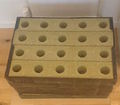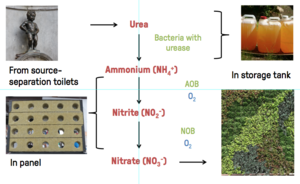Edible wall old
This page is under construction!
Contact
See main actors
Objectives and context
Motivation: upgrading to a multi-functional “living wall”
Our general motivation is to produce food on-site, while valorising excreta (human waste) and combining several advantages. In this project, our mission is to upgrade existing “living walls” to combine several functions and characteristics:
- Grow edible plants (or medicinal, scented… instead of just decorative exotic plants)
- Fertilise the plants with human source-separated urine only (and avoid using any chemical fertiliser)
- Purify indoor air, which passes through the soil and root system
- Use material that is renewable, locally available, … (as much as possible)
- Have a beautiful planted wall, that increases well-being in offices, inside buildings, or in the city
Among these functions, we want to focus in priority on valorising human urine to grow edible plants. Yerk?! Yes, you read it correctly. And you should get convinced of the many advantages of the reuse of urine for agriculture by reading this.
System description and constraints
It’s not just pots of plants stacked above each other. It’s not just an outdoor garden fertilised from time to time by urine. It’s not exactly a hydroponic system. All or these are already known. We have a combination of all, tadam...
Soil substitute
The vertical “modules” currently consists of panels of a kind of compressed roock wool called Grodan (although we might change this in the future if we find another renewable material with the same properties). The plants are planted in holes, and their roots then develop through this 'matrix' and at the back of the panels. Specificity: very little real natural soil, lightweight.
Fertigation (= irrigation + fertilisation)
Drip irrigation, with a nutritive solution made of tap water and currently a chemical fertiliser, which we’ll replace by urine. Similarly to a hydroponic system, the solution must contain all nutrients needed by the plants, in a readily available form, and in the appropriate concentration for continuous fertigation (as opposed to punctual fertilisation).
Plants for vertical indoor garden
Once we figured out the urine fertigation issue, we will identify edible & useful plants adapted to the urine-based nutrients mix. We will also try to design vegetal communities with beneficial symbiotic interactions between plants through companion planting. Companion planting may ease pest control and foster synergetic growth between different species.
Specific objectives
Challenge for urine fertigation in a semi-hydroponic system We want to :
- Avoid odours: especially because this version of living walls is designed for inside buildings.
- Find the ideal urine dilution: to provide the nutrients required by our plants mix, while to avoiding excessive fertilisation and ammonium toxicity.
- Nitrify urine with the simplest possible system: ideally in the panels.
In fact, most plants prefer nitrate-nitrogen to ammonia-nitrogen as a nitrogen source, as they are are easily damaged by excessive ammonium nutrition. <ref name="Shinohara2008"> Shinohara, M., Ohmori, H., & Uehara, Y. (2008). Microbial ecosystem constructed in water for successful organic hydroponics. Nature Precedings. </ref> <ref name="hydroponiefr1"> “Cette forme d’azote peut s’avérer toxique selon le type de plante et leur stade de croissance. Ainsi, les jeunes pieds de tomates font une grosse consommation d’ion NH4+. L’azote ammoniacale est prélevé en premier par les plantes, avant les ions nitrates. Toujours est-il qu’une plante peut se nourrir exclusivement d’ions NO3–, mais que l’apport unique d’ion ammonium NH4+ est toxique pour les végétaux. On rencontre cet ions ammonium dans la solution nutritive suite à la dissociation de sels de phosphate d’ammonium (NH4 H2PO4 ) surtout dans le but d’apporter des ions phosphates. Cependant, dans la solution nutritive l’ion ammonium fait concurrence au prélèvement d’ions K+, Mg++, Ca++. Le professeur Morard recommande que l’ion ammonium NH4+ n’excède pas 10% de l’azote assimilable contenu dans une solution nutritive.”
http://hydroponie.fr/azote/ </ref> <ref name="wikinitrateammonium1"> “Au delà d'une certaine dose, l'amonitrate est toxique pour les plantes dites « supérieures » et a été étudiée chez d'autres organismes modèles ou bioindicateurs potentiels (paramécies, mousse, lichens)11 ; cette toxicité se traduit chez la plupart des espèces par une réduction de la croissance, des feuilles plus petites et un retard de développement du système racinaire. A dose plus importante, les symptômes d'une chlorose apparaissent et peuvent conduire à la mort de la plante. [...] La toxicité de l'ion ammonium pour les plantes est encore imparfaitement connue ; elle est généralement attribué à un effet synergique associant : • une carence nutritive induite par l'excès d'ammonium (qui altère l'absorption des ions métalliques) ; • une acidification du milieu d'enracinement (qui inhibe la croissance racinaire secondaire) ; • une perturbation de l'équilibre osmotique de la plante (par modifications du pH intracellulaire) ; • un désaccouplement du phénomène de photophosphorylation liée au transport d'électrons, suite à l'accumulation d'ions ammonium dans les feuilles ; • l'altération du métabolisme des phytohormones et de la polyamine.”
https://fr.wikipedia.org/wiki/Nitrate_d%27ammonium#.C3.89cotoxicit.C3.A9 </ref>
This is why most hydroponic solutions contain nitrates, not ammonium <ref name="hydroponiefr1" /><ref name="wikinitrateammonium1" />. However stored urine contains nitrogen in the form of ammonium, which must therefore be converted to nitrate through nitrification. This requires the presence of nitrifying bacteria and sufficient oxygenation <ref name="wikinitrification1">"Nitrification is an aerobic process performed by small groups of autotrophic bacteria and archaea."
https://en.wikipedia.org/wiki/Nitrification</ref>. It is generally the case in soil… <ref name="wikinitrification2"> "In most environments, organisms are present that will complete both steps of the process." https://en.wikipedia.org/wiki/Nitrification</ref> but how about in our living walls, in our soil substitue? Is it a suitable medium to host active nitryfiers?
For this reason, we first want to test the 'nitrification in Grodan' (our soil substitute), and then proceed to test 'nitrification in modules' (fully assembled living wall modules).
We will also need to avoid excessive nitrogen fertilisation, which also causes damages, such as late maturation, increased sensitivity to pests, as well as nitrates accumulating in plants and ultimately reducing blood oxygenation in humans consuming them. <ref name=hydroponiefr2> "Les premiers signes d’un surdosage en engrais riche en azote est un feuillage vert foncé….Attention cependant à ne pas confondre les excès d’azote avec les carence en phosphore. L’excès d’azote contribue à développer une grosse masse foliaire au dépend du système racinaire. Cette surabondance d’ions azotée concourt au retard de la floraison chez de nombreuse plantes. Les solutions nutritives avec excès d’azote entraînent diverses conséquences sur le plan cultural :
– Un excès de végétation peut provoquer un recul de la maturité des plantes,
– Les plantes sont plus sensibles aux attaques des ravageurs et aux maladies fongiques (botrytis, mildiou, oïdium). Cela est le contrecoup de l’excès de végétation : les tissus (tiges, feuilles) sont tendres et constitue une barrière trop fragile pour s’opposer aux pathogènes.
– Enfin, une sur-fertilisation en azote, en plus de la détérioration des qualités gustatives, entraîne une teneur excessive en nitrates dans les légumes (essentiellement les légumes feuilles tel la laitue Il n’y a pas de danger pour les légumes-fruit comme les Tomates, Concombres). L’excès de nitrates chez l’homme causent une baisse de l’oxygénation du sang."
http://hydroponie.fr/azote/ </ref>.
Questions for experiments
- Nitrification in modules - Does nitrification of urine take place in our soil substitutes? Is it quick enough? How it it influenced by the following factors?
- Inoculation (none / with nitrifying solution)
- Dilution factor (between 1:10-1:50)
- aeration properties of the panels (free surface / covered with a plastic sheet / active aeration)?
- Different soils, i.e. different source of microorganisms (none? / special for germination, sterilised / garden compost / field, without chemicals? / inocculated with an nitrifying culture)
- What is the ideal dilution rate?
- Limit to prevent odours
- Appropriate dilution to reach at least the same performance as the chemical solution (or compare between dilutions) – in these modules
- How do different edible plants grow under these conditions? Which are the most adapted?
- First selection: common herbs that grow well
- More interesting other plants: 2nd run, or first just in pots vertically – pre-test the dilutions
- Could we start this last point in parallel during the nitrification experiments, or if it takes very long to build the structure, or in collaboration with Vertikal Farms ? (TBD)
People involved
Main actors: Alexandra & Michka (easy to find on Slack or by e-mail)
Participants (have helped us so far):
- at Hackuarium: Of course Yann H. & Yann P. and also Clément Drévo., Miram Ryf …
- colleagues at ESTEE: Saida N., Théodore B., Tomas R.
External partners: We cooperate with the enterprises Biotecture and Living Green City UK. They produce and install living walls inside and outside buildings. Biotecture have provided us with the core of the modules and share some know-how. The team at Living Green City UK, in London, currently focus on air filtration function. We are in contact with them especially to ensure the integration of the different functions.
Friends and related projects: Vertical / urban farming, aquapony, and such species: Vertikal farms, Exodes Urbains, others met
Communication: Slack channel: #wg-edible-wall
Activities
Overview of project parts
Details on these activities will be found in the following sections (title level 2 or links to separate pages).
- Urine Fertigation
- Urine collection and storage
- Wall structure and irrigation system – design & build
- Experiments of nitrification (series Nx)
- Grow a community of nitrifying bacteria (NA)
- Preliminary odour test
- Test the nitrification in Grodan (our soil substrate) (NG)
- experiment NG1 - Grodan samples, initial inoculation, several urine dilutions tested
- experiment NM2 - with inoculation through different soils
- Dilution tests
- Vegetal Community
- Nursery: design, build and plant
- Selection guide for different conditions (such as indoor/outdoor, light, space, etc.)
- Select and gather plants for the first experiments
- Matrix for indoor walls
- Integration of air filtration
- Idea taken into account in the part “nitrification in modules”. Details will come later.
Experimental plan
This file shows an overview of the experiments planned, to which questions they should answer, and their sequence depending on the results of the first ones: File:Experiment Plan 11.08.2015 - attach to wiki.pdf
News:
13.07.2015 We've received the empty modules!
22.07.2015 openHackuarium vol.55 Here's our small presentation of project plans
23.07.2015 First results: our nitrifying culture is active!
Urine collection & storage
See the page DIY waterless urinals (This may serve also to other projects!)
Nitrifiying culture (NA)
We'll create a page with more details when we see the first results!
Quick reminder of objective
Grow a culture of nitrifying bacteria adapted to diluted urine. It can then serve in 1° for us to:
- Inocculate our modules with the suitable microorganisms, if needed
But also to:
- Start an aquaponic system (with fish etc)
- Stabilise diluted urine, with the effect of removing pathogens and smell => home fertiliser that's better than simple urine
Inspiration / background
We got inspiration from this
- protocol to start an aquaponic system (in french)
They want to keep the ammonium conc very low, good for fish. Target 2-4 ppm, increased by 0.5ppm daily. But in our case, we want a culture adapted to much higher concentrations; at least those used for fertigation. Try to go faster?
... more to come
Wall structure and irrigation system
Test the nitrification in modules – experiment
Dilution test: planted experiment
References
<references/>



